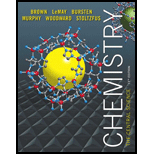
Interpretation: The symbol corresponding to each isotope in the given table is to be determined; also the isotope which is unstable, one which has magic number of protons and neutrons and one which yield potassium-39 after proton emission is to be determined.
Concept Introduction: The symbol of the given isotope is determined by the
The unstable isotope is the isotope which has least half life.
The magic numbers are
The isotope which releases potassium-39 on positron emission must have mas number greater than 39.
(a)
To determine: The symbols of the each of the given isotopes.
Step 1:
To determine: The symbol of the given isotope.
Step 2:
To determine: The symbol of the given isotope.
Step 3:
To determine: The symbol of the given isotope.
Step 4:
To determine: The symbol of the given isotope.
(b)
To determine: The isotope which is most likely to be unstable out of the given isotopes.
(c)
To determine: The isotopes which contain magic number of neutrons and protons out of the given isotopes.
(d)
To determine: The isotope which yields potassium-39 after proton emission.
Want to see the full answer?
Check out a sample textbook solution
Chapter 7 Solutions
Chemistry: The Central Science (13th Edition)
 ChemistryChemistryISBN:9781305957404Author:Steven S. Zumdahl, Susan A. Zumdahl, Donald J. DeCostePublisher:Cengage Learning
ChemistryChemistryISBN:9781305957404Author:Steven S. Zumdahl, Susan A. Zumdahl, Donald J. DeCostePublisher:Cengage Learning ChemistryChemistryISBN:9781259911156Author:Raymond Chang Dr., Jason Overby ProfessorPublisher:McGraw-Hill Education
ChemistryChemistryISBN:9781259911156Author:Raymond Chang Dr., Jason Overby ProfessorPublisher:McGraw-Hill Education Principles of Instrumental AnalysisChemistryISBN:9781305577213Author:Douglas A. Skoog, F. James Holler, Stanley R. CrouchPublisher:Cengage Learning
Principles of Instrumental AnalysisChemistryISBN:9781305577213Author:Douglas A. Skoog, F. James Holler, Stanley R. CrouchPublisher:Cengage Learning Organic ChemistryChemistryISBN:9780078021558Author:Janice Gorzynski Smith Dr.Publisher:McGraw-Hill Education
Organic ChemistryChemistryISBN:9780078021558Author:Janice Gorzynski Smith Dr.Publisher:McGraw-Hill Education Chemistry: Principles and ReactionsChemistryISBN:9781305079373Author:William L. Masterton, Cecile N. HurleyPublisher:Cengage Learning
Chemistry: Principles and ReactionsChemistryISBN:9781305079373Author:William L. Masterton, Cecile N. HurleyPublisher:Cengage Learning Elementary Principles of Chemical Processes, Bind...ChemistryISBN:9781118431221Author:Richard M. Felder, Ronald W. Rousseau, Lisa G. BullardPublisher:WILEY
Elementary Principles of Chemical Processes, Bind...ChemistryISBN:9781118431221Author:Richard M. Felder, Ronald W. Rousseau, Lisa G. BullardPublisher:WILEY





